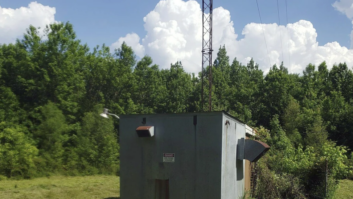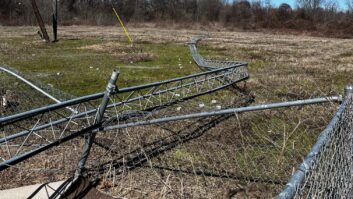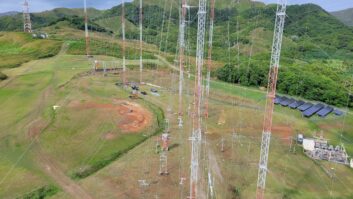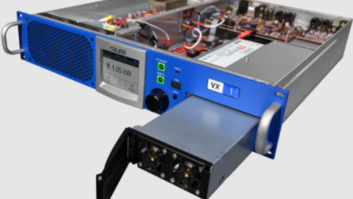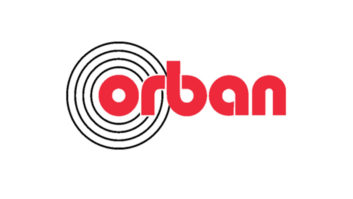Ralph Jones does contract work in California. When he read our request for pictures of “worst sites,” one came to mind.

Fig. 1: The transmitter shack — complete with live AC wiring running along the ground.

Fig. 2: It’s not a transmitter building, it’s a trash dumpster. When Ralph took over contract work for the facility pictured in Fig. 1, it didn’t look bad at first — until he realized that the black lines visible in the dirt, leaving the bottom edge of the building, are wires for the 220 VAC feed.
It gets better. Ralph opened the door and was greeted by the mess seen in Fig. 2. It looks like the building had been used more to store junk and trash than house a transmitter. We’ve all been there at one time or another, haven’t we?

Fig. 3: This temporary fix for a missing connector has become permanent. Note the cobwebs. Fig. 3 shows a field-expedient RF connection that probably had been used to get the station on the air in the absence of a proper connector flange fitting. Perhaps a good idea at the time; but like so many quick fixes, it was left to become permanent.
In this case, the 1-1/4-inch coaxial cable is connected to a 1-5/8 EIA Bird line section. The outer conductor on the coax had been peeled back, like a banana skin, then bolted to the flange! Ralph found the inner conductor loosely connected to the bullet with two hose clamps.
Things weren’t much better out by the tower. Fig. 4 shows the transmission line just waiting for copper thieves. How does the building look now?
Ralph had a lot of help straightening the place out. With the coaxial feeder lying on the ground, one bright idea was a transmission line cage, seen in Fig. 5. Station ownership resisted due to cost; but with a subdivision less than 200 yards away, Ralph says he was concerned about lawsuits and copper thieves.

Fig. 4: In a day where copper theft is rampant, it’s amazing this gold mine wasn’t tapped. The fenced cage, with barbed wire along the top and the cable now elevated off the ground inside, is an effort to protect the line from theft or vandalism. So far it’s worked.
Nothing’s perfect, however. Budget constraints would not allow use of a rigger to tie down the coax on the tower, so it snakes around as it makes its way to the antenna, seen in the background of Fig. 5. I guess you can’t have it all.
The particle board shack has been replaced with an insulated shipping container, shown in Fig. 6. The dual-staged air conditioning system means no inside temperatures in excess of 100 degrees F. Ralph added a sliding patio-style door just inside the steel container doors. This allows the security doors to be open during maintenance sessions, while keeping the dust and heat out of the building.
Ralph is looking for work (not because of these “before” pictures, he adds with a chuckle).
Got a before-and-after site you want to share? E-mail the high-resolution photos with details to [email protected].
* * *
Hal Kneller is market development manager for Nautel, where I work; he also has experience at iBiquity and Harris and is a great resource for engineers.

Fig. 5: Here’s a means of protecting cable against vandalism when it can’t be buried.

Fig 6: After improvements, here’s a transmitter building of which we can be proud. Hal received an inquiry recently regarding replacement FETs (field effect transistors) used in the Harris Gates and SX series transmitters. A good number of these transmitters remain in service but the FETs, which are no longer manufactured, are getting harder to find.
About 10 years ago, Hal sent in a tip that International Rectifier’s IRF350 generic replacement FET worked just fine in these transmitters. In fact, Hal used them in an SX-1 at an AM station he owned at the time. Hal’s original source, Mouser, no longer carries this model FET, but Newark does; visit www.newark.com and enter International Rectifier IRF350 in the search block.
The Newark price is about $12 if you order a quantity of up 24. Search around the Internet and you may find other sources as well. Consider future needs so you have a supply if existing sources dry up.
With that in mind, Hal reports that Harris has re-spun the PA boards, which use a newer plastic device today. As for the IRF replacement, Hal verified this number with Harris service. So tuck this information away if you maintain these transmitters or do contract work.
John Bisset marked his 40th year in broadcasting last month. He is international sales manager for Europe and Southern Africa for Nautel and a past recipient of SBE’s Educator of the Year Award. Reach him at[email protected]. Faxed submissions can be sent to (603) 472-4944.
Submissions for this column are encouraged and qualify for SBE recertification credit.





